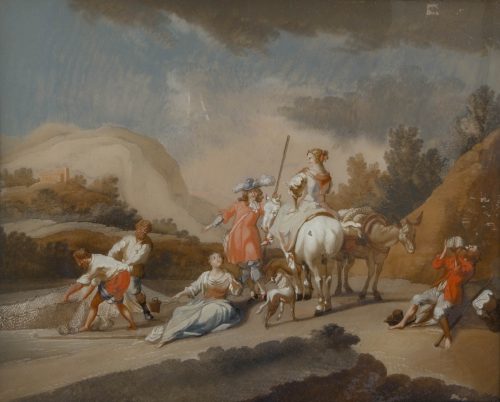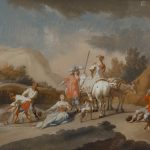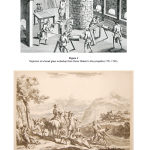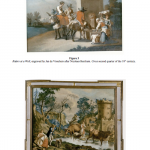9919 REVERSE GLASS PAINTING DEPICTING FIGURES NEAR A RIVERBANK IN A MOUNTAINOUS LANDSCAPE Augsburg. Early 18th Century. Measurements: Height: 10 3/4″ ( 27.3 cm) Width: 13 1/2″( 34.3 cm)

Research
Oil on glass in original molded pearwood frame.
The present artwork is an example of the reverse glass painting being produced in 18th century Augsburg, which ranked “among the most important centres for the commercial arts”1 and was “the best-known and most prolific center in Europe for reverse painting.”2
Reverse glass painting, also referred to as Hinterglas Malerei, has its origins in antiquity, but truly flourished between the mid-16th and mid-19th centuries, blossoming fist in the Venetia-Tyrol region in the 1550s. Improvements in the production of flat glass and the circulation of prints and engravings led to increases in the number, quality, and variety of designs available. Glass for this purpose was typically made by the so-called blown cylinder or broad glass method, in which molten glass was collected at the end of a blowpipe and blown into an elongated bubble; the ends were cut off and a slit was made down the body of the resulting cylinder, which was then heated again until it could be unrolled into a flat sheet (figure 1).
The scene of the present painting, Riverbank with fishermen hauling in nets watched by a lady seated on a horse; at left a thirsty traveler drinks from a jug on the roadway, is copied from a print by Johannes Visscher after a drawing by Nicolaes Berchem, a Dutch painter known for his series of shepherds. A circa 1670 version is held in the collection of the British Museum (figure 2) while a second Visscher engraving, but in reverse, is in the collection of the Fitzwilliam Museum, Cambridge. “Berchem’s works were used as models for engravings more than those of any other Dutch painter of the 17th and 18th century,”3 and “landscapes based on works by the 17th century Netherlandish masters were very popular among the Augsburg Hinterglas painters in the second half of the 18th century.”4
The overall character of the present painting is similar to a group of other reverse glass paintings identified as Augsburg productions from the second half of the 18th century, and also deriving from the works of Visschers and Berchem, including Riders at a Well and Rural Scene with Herdsmen (figures 3 and 4).
Footnotes:
- Steiner, Wolfgang. Hinterglas Und Kupferstich: 100 Bisher Unvero öffentlichte Hinterglasgema älde Und Ihre Vorlagen Aus Drei Jahrhunderten (1550-1850) = Reverse Paintings on Glass : 100 Previously Unpublished Reverse Paintings on Glass and the Engravings on Which They Were Based, from 1550 to 1850. Mu ünchen: Hirmer, 2004. 11.
- Ibid., 15.
- Ibid., 255
- Ibid.



Comments are closed.